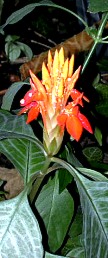
|
Whitcomb - Nursery Practices 3
This is
where the marriage of techniques comes in . . .
|
- Place the
root ball in an above-ground container, surrounding it with
a good container
growing medium (mix) that contains micronutrients and slow-release
fertiliser of a form that will last roughly six to eight months.
- The new mix
around the root ball insulates the fibrous, concentrated root
mass in the soil ball for the rest of the winter in most areas
of hardiness zones 6,7,8 and 9. Some additional protection may
be needed in more northern areas depending on the date of planting
in containers. The center of the container, with the roots in
field soil, holds
water and nutrients well. The mix around the outside provides
drainage, oxygen and an excellent environment for root growth.
Water the trees normally.
- Complete
the task of shifting plants from the field to containers BEFORE
spring buds swell.
- When spring
bud swell occurs, a surge of new roots will extend from the root
ball of field soil out into the container mix.
- In north-central
Oklahoma, trees pulled and placed in containers in February or
March are rooted out and generally ready to sell about one month
after leaves emerge.
Let's spell out the advantages
- Establishment
in the container does not require many months or a full growing
season: it is far faster if mix, nutrition, watering and weed
control are properly managed.
- This procedure
provides the quality of top that can only be achieved in the field,
but does so
with the convenience and mobility of plants grown in containers.
Best of all, you have exceptional quality trees to sell all summer.
- Because the
expensive large containers and soilless mix are purchased only
at the time of harvest, you do not tie up valuable dollars for
long periods of time.An even more economical alternative is to
use the RootBuildertm container which
continues the air-pruning process through a honeycomb of openings
throughout the sidewall, yet is very easy to remove at the time
of planting into the landscape, and can be used over and over
again.
- No heavy
equipment or tree spades are necessary.
A 30 hp. tractor with front loader or three-point lifting arm
will provide all the muscle you need.
- Because the
roots have not been in
the container for years, the circling and deformity pitfalls of
conventional containers are less of a problem.
- Growing trees
in the field in the knit fabric grow bags, then establishing them
in containers before sale provides the maximum of energy for root
growth. Plant trees grown with this procedure into the landscape
during May through September (even the hottest days of August),
and by the following summer the trees are established. Losses
are few, stress tolerance is high, and customer satisfaction is
excellent.
- At the present
time this is my favorite way for growing trees, and trees are
available for sale when demand is greatest. The nursery industry
needs to focus on selling shade in the summer when shade is a
motivation to buy. Likewise, the best time to offer flowering
trees for sale is when they are in full bloom. Using this growing
procedure, that is perfectly possible. As one recent convert said,
"The thing that convinced me was when we loaded large crapemyrtle
trees in full bloom in August, planted them in the landscape and
they never quit flowering. The customer thought we were magicians."
- I am not
saying that other nursery procedures do not work, but there are
degrees of success and varying levels of return for your investment.
After years of experimentation, I have found the way that suits
me and has given nothing but great results.
Carl E. Whitcomb, Ph.D, is president of Lacebark Research,
Stillwater, OK
Back to
Table of Contents
1 |
2
|
|